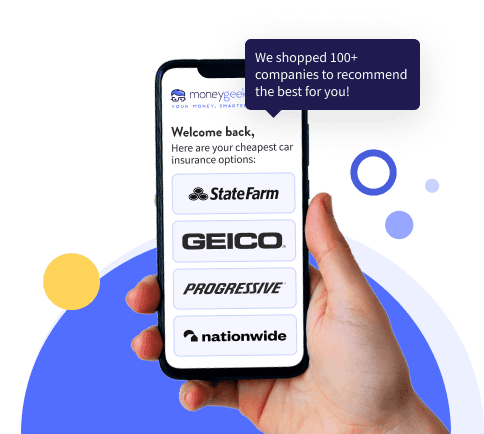Bodily injury liability covers medical expenses and lost wages, while property damage liability pays for damage to someone else's vehicle or property.
What Is Liability Car Insurance Coverage?
Liability coverage pays for injuries and property damage you cause to others. It doesn't cover your own expenses.
Find out if you're overpaying for car insurance below.

Updated: October 29, 2025
Advertising & Editorial Disclosure
In car insurance, liability coverage is mandatory in most states except New Hampshire.
Liability coverage pays for third-party injuries and property damage up to your policy limits. Anything exceeding your limits is your responsibility.
Liability insurance doesn't cover your injuries, damage to your vehicle or protection against uninsured or underinsured drivers.
Ensure you are getting the best rate for your insurance. Compare quotes from the top insurance companies.
How Does Liability Car Insurance Coverage Work?
- Emergency room visits and hospital stays
- Surgery or physical therapy
- Lost income from missed work
- Legal defense fees if you're sued
- Funeral costs if the accident is fatal
- Pain and suffering damages awarded in court
- Repairing another driver’s car
- Replacing a totaled vehicle
- Fixing a damaged fence, mailbox or garage
- Paying for damage to city property like traffic lights or road signs
- Covering rental car costs for the other party while their car is being fixed
- Legal fees if you're sued for property damage
Bodily injury liability covers medical expenses, lost wages and legal fees if you injure someone in an accident where you're at fault. It pays for the other party's costs, not your own.
Property damage liability covers the cost of repairing or replacing someone else’s property when you’re at fault in a car accident. It doesn’t cover your own vehicle or belongings, just the damage you cause to others.
How to Claim Liability Insurance
Liability coverage in car insurance pays for injuries and property damage you cause to others in an at-fault accident. Knowing the claims process helps you respond quickly and avoid costly mistakes.
- 1Report the Accident to Your Car Insurance Company
Contact your insurer immediately after the accident to start the liability claims process. Share key details like the time, location, people involved and any police report number.
- 2Allow the Insurer to Investigate the Accident
Your insurance company assigns a claims adjuster to determine fault. The adjuster collects and reviews evidence, including photos, witness statements and police reports.
- 3Confirm Fault and Liability Coverage
If you’re found at fault, your liability insurance will apply up to your coverage limits. Your insurer will inform you of the total payout amount and what it covers.
- 4Let the Insurer Pay the Injured Party
Your insurance company will send payment directly to the injured party or their insurer. The payment goes directly to the injured party but gets recorded as a liability claim under your policy.
- 5Prepare for Possible Premium Increases
Filing a liability claim can raise your insurance premium at renewal. The increase depends on the claim size and your overall driving and claims history.
If someone sues you after an accident, your liability coverage provides legal defense up to your policy limits. Your insurance company assigns experienced attorneys to represent you and covers all court costs and legal fees. This protection is worth hundreds of thousands of dollars in complex cases.
Your insurer defends you vigorously because they pay any judgment up to your policy limits. They work to minimize both your exposure and their financial liability.
Who Does Car Liability Insurance Cover?
Liability coverage covers you and anyone driving your car with your permission. It doesn't cover people driving your car without permission or using it for commercial purposes.
Who is covered:
- You (the primary policyholder)
- Your spouse or partner if they’re listed on the policy
- Family members in your household
- Friends or others who have your permission to drive your car
Who isn’t covered:
- Household members not listed on your policy
- Drivers who use your car without your permission
- Anyone using your car for business or delivery without proper coverage
- People using your car for excluded uses (like racing or rideshare, unless added)
What Does Car Liability Coverage Not Cover?
Liability insurance doesn't cover your medical bills, rehabilitation costs, vehicle repairs, replacement costs, rental car expenses or lost wages from injuries. For protection against these costs, you need comprehensive and collision coverage.
You're personally responsible for medical costs exceeding your per-person limit, total accident costs beyond your per-accident limit, property damage above your coverage amount, and legal judgments that surpass your total coverage.
Most policies cover accidents in the United States and Canada, though international travel may require additional coverage. Coverage applies to accidents during your policy period, regardless of when claims are filed.
Liability coverage doesn't apply to intentional damage you cause, commercial use of your personal vehicle, racing or speed contests, damage while committing a crime, or using your car for rideshare without proper coverage.
If an uninsured driver hits you, liability insurance won't help. You need uninsured motorist coverage for protection.
How Much Liability Insurance Do I Need?
Most states require drivers to have auto insurance coverage; New Hampshire and Virginia are the exceptions. While minimum car insurance requirements vary by state, liability coverage is always required.
State | Bodily injury liability (per person) | Bodily injury liability (per accident) | Property damage liability (per accident) | Other car insurance requirements |
|---|---|---|---|---|
Alabama | $25,000 | $50,000 | $25,000 | None |
Alaska | $50,000 | $100,000 | $25,000 | None |
Arizona | $25,000 | $50,000 | $15,000 | None |
Arkansas | $25,000 | $50,000 | $25,000 | None |
California | $30,000 | $60,000 | $15,000 | None |
Colorado | $25,000 | $50,000 | $15,000 | None |
Connecticut | $25,000 | $50,000 | $25,000 | Uninsured/underinsured motorist bodily injury: $25,000 per person $50,000 per accident |
Delaware | $25,000 | $50,000 | $10,000 | Personal injury protection: $15,000 per person $30,000 per accident |
District of Columbia | $25,000 | $50,000 | $10,000 | Uninsured/underinsured motorist bodily injury: $25,000 per person $50,000 per accident Uninsured/underinsured property damage: $5,000 (subject to $200 deductible) |
Florida | $10,000 | $20,000 | $10,000 | Personal injury protection: $10,000 |
Georgia | $25,000 | $50,000 | $25,000 | None |
Hawaii | $20,000 | $40,000 | $10,000 | Personal injury protection: $10,000 |
Idaho | $25,000 | $50,000 | $15,000 | None |
Illinois | $25,000 | $50,000 | $20,000 | Uninsured motorist bodily injury: $25,000 per person $50,000 per accident |
Indiana | $25,000 | $50,000 | $25,000 | None |
Iowa | $20,000 | $40,000 | $15,000 | None |
Kansas | $25,000 | $50,000 | $25,000 | Personal injury protection: $4,500 Uninsured/underinsured motorist bodily injury: $25,000 per person $50,000 per accident |
Kentucky | $25,000 | $50,000 | $25,000 | Personal injury protection: $10,000 |
Louisiana | $15,000 | $30,000 | $25,000 | None |
Maine | $50,000 | $100,000 | $25,000 | Medical payments: $2,000 Uninsured/underinsured motorist bodily injury: $50,000 per person $100,000 per accident |
Maryland | $30,000 | $60,000 | $15,000 | Personal injury protection: $2,500 Uninsured/underinsured motorist bodily injury: $30,000 per person $60,000 per accident Uninsured motorist property damage: $15,000 |
Massachusetts | $20,000 | $40,000 | $5,000 | Personal injury protection: $8,000 per accident Uninsured/underinsured motorist bodily injury: $20,000 per person $40,000 per accident |
Michigan | $20,000 | $40,000 | $10,000 (for damage your vehicle does to property in another state) | Personal injury protection: Unlimited per person Unlimited per accident Property protection: $1 million |
Minnesota | $30,000 | $60,000 | $10,000 | Personal injury protection: $40,000 per person Uninsured/underinsured motorist bodily injury: $25,000 per person $50,000 per accident |
Mississippi | $25,000 | $50,000 | $25,000 | None |
Missouri | $25,000 | $50,000 | $25,000 | Uninsured/underinsured motorist bodily injury: $25,000 per person $50,000 per accident |
Montana | $25,000 | $50,000 | $20,000 | None |
Nebraska | $25,000 | $50,000 | $25,000 | Uninsured/underinsured motorist bodily injury: $25,000 per person $50,000 per accident |
Nevada | $25,000 | $50,000 | $20,000 | None |
New Hampshire | $25,000 | $50,000 | $25,000 | Uninsured/underinsured motorist bodily injury: $25,000 per person $50,000 per accident |
New Jersey | $15,000 | $15,000 | $5,000 | None |
New Mexico | $25,000 | $50,000 | $10,000 | None |
New York | $25,000 | $50,000 | $10,000 | Personal injury protection: $50,000 per person Liability for death: $50,000 per person Uninsured/underinsured motorist bodily injury: $25,000 per person $50,000 per accident |
North Carolina | $30,000 | $60,000 | $25,000 | Uninsured/underinsured motorist bodily injury: $30,000 per person $60,000 per accident Uninsured/underinsured motorist property damage: $25,000 |
North Dakota | $25,000 | $50,000 | $25,000 | Personal injury protection: $30,000 per person Uninsured/underinsured motorist bodily injury: $25,000 per person $50,000 per accident |
Ohio | $25,000 | $50,000 | $25,000 | None |
Oklahoma | $25,000 | $50,000 | $25,000 | None |
Oregon | $25,000 | $50,000 | $20,000 | Uninsured/underinsured motorist bodily injury: $25,000 per person $50,000 per accident |
Pennsylvania | $15,000 | $30,000 | $5,000 | Medical payments coverage: $5,000 |
Rhode Island | $25,000 | $50,000 | $25,000 *or $75,000 combined single limit | None |
South Carolina | $25,000 | $50,000 | $25,000 | Uninsured/underinsured motorist bodily injury: $25,000 per person $50,000 per accident |
South Dakota | $25,000 | $50,000 | $25,000 | Uninsured/underinsured motorist bodily injury: $25,000 per person $50,000 per accident |
Tennessee | $25,000 | $50,000 | $15,000 | None |
Texas | $30,000 | $60,000 | $25,000 | None |
Utah | $30,000 | $65,000 | $25,000 | Personal injury protection: $3,000 per person Uninsured motorist coverage: $30,000 per person $65,000 per accident |
Vermont | $25,000 | $50,000 | $10,000 | Uninsured/underinsured motorist bodily injury: $50,000 per person $100,000 per accident Uninsured/underinsured property damage: $10,000 |
Virginia | $50,000 | $100,000 | $25,000 | None |
Washington | $25,000 | $50,000 | $10,000 | None |
West Virginia | $25,000 | $50,000 | $25,000 | Uninsured/underinsured motorist bodily injury: $25,000 per person $50,000 per accident |
Wisconsin | $25,000 | $50,000 | $10,000 | Uninsured/underinsured motorist bodily injury: $25,000 per person $50,000 per accident |
Wyoming | $25,000 | $50,000 | $20,000 | None |
Who Needs More Than Minimum Car Liability Coverage?
Minimum liability insurance meets legal requirements in most states, but it doesn't fully protect you in serious accidents. If damage exceeds your policy limits, you pay the difference out of pocket.
If your net worth exceeds $500,000, you're more likely to face lawsuits after serious accidents. Minimum liability insurance won't cover large legal judgments, putting your savings, home or business at risk. Higher liability limits and umbrella coverage protect your financial assets.
Frequent highway driving or long commutes raise your chances of high-cost accidents involving severe injuries and property damage that exceed minimum liability limits. Higher liability coverage offers stronger financial protection.
Teen drivers face accident rates nearly three times higher than experienced drivers, making them significant liability risks. Minimum liability coverage doesn't cover the full cost of injuries or damage caused by inexperienced drivers. Higher liability limits better protect your family from financial loss.
Owning multiple cars increases your chances of filing multiple liability claims. Basic liability coverage doesn't stretch far enough in multi-claim situations. Higher limits ensure you're fully protected across all vehicles and drivers.
Using your car for business exposes you to risks that personal auto insurance doesn't cover. If you cause an accident while working, minimum liability insurance leaves you with coverage gaps. Higher liability limits and business-use coverage fill those gaps.
City driving means more accidents, higher medical bills and expensive repairs. Minimum liability coverage falls short in dense urban areas with complex claims. Higher liability coverage protects you from big-city risks.
What Happens if Claims Exceed Your Coverage?
If liability claims exceed your coverage limits, you'll pay out of pocket for medical bills, property damage or legal judgments.. The injured party may pursue your savings, income or other assets to recover the difference. Choosing higher liability coverage limits helps protect you from this financial risk.
How Much Does Liability Coverage Cost In Car Insurance?
Liability insurance costs vary by state based on minimum requirements, accident rates, medical costs and legal environments. MoneyGeek's analysis of 83,056 quotes shows state-minimum liability-only policies average $1,273 per year, ranging from $653 to $1,708 by state.
Compare Liability Car Insurance Quotes
Comparing car insurance quotes helps you find the best rates. Getting an online estimate requires information like your ZIP code, age range, current coverage status, number of vehicles, homeowner status, credit score range, traffic incidents and military status. If you're uncomfortable sharing personal details, you may request car insurance quotes anonymously.
MoneyGeek's calculator can also help you get quick quotes from multiple providers. Use this tool to get accurate estimates based on your needs.
Car Insurance Calculator
MoneyGeek's car insurance calculator will give you a customized estimate of your auto insurance cost. It's free to use, requires no personal information and we won't send you any spam.
Rates updated:
Nov 29, 2025
Your Next Step:
Get your real quotes from trusted insurance providers.
Although MoneyGeek partners with some of the companies we recommend, our content is written and reviewed by an independent team of writers, editors and licensed agents. Learn more about our editorial policies and expert editorial team.
Factors That Affect Liability Coverage Cost
Your liability insurance cost depends on your risk profile. Drivers with clean records, good credit and safe vehicles pay less. City drivers pay more than rural drivers.
Your rates depend on your driving history, age, location and coverage limits. Here's how each factor affects your cost:
Your Driving Record
Your driving history is the biggest factor in liability insurance costs. Accidents, tickets and DUIs raise your rates above drivers with clean records. Minor tickets increase your rates for a few years, but maintaining a clean record lowers your premiums over time.
Age and Experience
Young drivers pay substantially more for liability insurance because they crash more often. Teens face the highest rates, but rates decrease with age and experience, especially after 25. Drivers over 70 see small increases but still pay much less than teenagers.
Location and Geography
Where you live affects what you pay. City driving with heavy traffic and more accidents costs more than rural areas. Your exact ZIP code matters too: if your neighborhood sees lots of accidents or car thefts, everyone there pays more.
State Laws
State regulations affect your rates. Some states prohibit insurers from using credit score or gender in pricing, while others allow it. States requiring no-fault insurance or high minimum coverage limits cost more.
Your Credit Score
In most states, good credit lowers liability rates since insurers correlate it with fewer claims. California, Hawaii, Massachusetts and Michigan prohibit credit-based pricing.
Vehicle and Usage Factors
High-performance cars and vehicles with poor safety ratings cost more to insure. Long commutes and high mileage increase accident risk and rates. Low annual mileage lowers your costs.
The Coverage Limits You Choose
Higher liability limits cost more, but less than many expect. Increasing from basic 25/50/25 coverage to 100/300/100 limits adds $20 to $30 per month. This modest increase provides substantially better protection.
Your Choice of Insurance Provider
Different companies charge different rates for the same coverage. Some focus on digital efficiency to reduce costs, while others invest in agent networks and customer service. Companies like USAA offer lower rates because their member demographics include safer drivers.
Unless you can cover a catastrophic accident out-of-pocket, liability insurance protects you from lawsuits when you're at fault. Even minimum coverage required by law doesn't fully protect you. Shopping around helps you find cheap car insurance that meets your needs.
How to Save Money on Liability Insurance
You can cut your liability insurance costs by shopping around, maximizing discounts and maintaining a clean driving record. The difference between the cheapest and most expensive liability coverage exceeds $1,000 annually. Here's how to avoid overpaying:
- 1Start Shopping Early
Start shopping two to four weeks before your policy expires. This gives you time to compare rates without rushing or risking a coverage gap.
- 2Get Multiple Quotes
Liability-only coverage ranges from about $650 to $1,700 per year depending on the company. That's a huge difference for the exact same protection, so don't just renew with your current insurer without checking what else is out there.
- 3Shop Regional Providers
Include smaller local insurers when shopping. These companies sometimes offer better prices and more personal service than national carriers. They may also assess risk differently, potentially benefiting your rate.
- 4Maximize Available Discounts
- Bundle your policies: Combine your auto and home or renters insurance to save 5% to 25% on both. Add an umbrella policy and you'll often get even more discounts while boosting your liability protection.
- Student discounts: Keep your grades up and save 10% to 25% on your premiums.
- Good driver and defensive driving discounts: Clean records earn you 10% to 30% off, while taking a defensive driving course can cut another 5% to 15%. The longer you go without accidents, the more you'll save.
- Safety feature discounts: Anti-lock brakes save you about 5%, while anti-theft systems cut 10% to 15%. Cars with top safety ratings often qualify for additional breaks since they're linked to fewer serious injuries.
- Low mileage discounts: Don't drive much? Save 5% to 15% since less time on the road means less accident risk.
- Group discounts: Check if your employer, alumni association, or professional group offers insurance discounts. Many do.
- Senior discounts: Drivers 50 and older often get mature driver discounts. Taking a senior driving course saves you more and helps offset age-related rate increases.
- 5Maintain a Clean Driving Record
Avoid tickets, accidents and serious violations like DUIs. Even one speeding ticket raises your rates for years. Clean driving records earn the best rates and largest discounts.
- 6Pay Your Policy in Full
Pay your policy annually instead of monthly to avoid installment fees and save without changing coverage.
- 7Consider 12-Month Terms
Compare annual and six-month policy terms. Some insurers discount longer terms, while others increase rates less frequently with shorter periods.
What Is Liability Car Insurance Coverage: Bottom Line
Liability insurance covers only bodily injury and property damage you cause to others. Drivers who prioritize cost often choose liability-only coverage as the most affordable option. However, it provides the least protection since it doesn't cover your own expenses or vehicle damage.
Ensure you are getting the best rate for your insurance. Compare quotes from the top insurance companies.
Liability Car Insurance: FAQ
Does liability insurance cover my car if I am at fault?
No; if you're at fault, liability insurance covers damage and injuries the other driver sustains. But, it only does so up to your policy's limits.
Repairs and medical treatments are costly, so ensure you have enough insurance coverage. Otherwise, you'll pay out-of-pocket for amounts exceeding your policy limits.
I drive but don't own a car. Should I get liability insurance?
If you don't own a car but drive regularly, coverage is essential. It provides financial protection when you borrow vehicles or rent cars.
A standard car insurance policy isn't the best choice for non-owners. Inquire with providers about cheap non-owner car insurance, which better fits your situation.
Is liability insurance required in every state?
No, New Hampshire and Virginia don't require liability, but Virginia charges an uninsured motor vehicle fee of $500 annually. All other states mandate minimum liability coverage.
What happens if I don't have enough liability coverage?
You're personally responsible for costs exceeding your policy limits. This could result in wage garnishment, asset seizure, liens on your property or forced bankruptcy.
How much liability coverage do I really need?
Consider coverage equal to your net worth as a starting point. If you have significant assets, high income or young drivers, consider higher limits or umbrella insurance for additional protection.
Will liability insurance cover me if I'm driving someone else's car?
Yes, if you have permission to drive. However, the car owner's insurance pays first, and your coverage provides secondary protection.
How do liability limits work in multi-car accidents?
Your per-person limit applies to each injured individual, but your per-accident limit caps total payouts. With 50/100/25 coverage, if you injure three people requiring $40,000 each in medical care, you'd pay $20,000 out-of-pocket ($120,000 total exceeds your $100,000 per-accident limit).
Best Liability Car Insurance Rates: Our Methodology
Liability-only insurance costs vary between companies—sometimes by over $1,000 per year for identical coverage. We designed our analysis to show you which insurers offer the lowest liability rates and how your driving record affects what you'll pay, so you can find affordable protection without overpaying.
What We Analyzed
We collected 83,056 quotes from 46 insurance companies across 473 ZIP codes using data from state insurance departments and Quadrant Information Services. Our analysis answers three critical questions for liability shoppers: Which companies charge the least for liability-only coverage? How much do violations increase your rates? When does upgrading from minimum liability to higher limits make financial sense?
Why This Research Matters for Liability Shoppers
Liability-only coverage attracts cost-conscious drivers, but the price gap between insurers is massive. We found some companies charge twice as much as others for the same state-minimum coverage. Since you're already choosing the most basic coverage to save money, picking the wrong insurer wastes hundreds of dollars annually. Our analysis identifies the consistently cheapest providers and shows you exactly how violations like tickets and accidents affect liability rates specifically.
Standard Driver Profile
We used a baseline profile to compare rates fairly: a 40-year-old man driving a Toyota Camry LE with a clean driving record. This profile represents moderate risk, not the lowest rates young drivers see or the highest premiums high-risk drivers pay.
We adjusted this profile by age, driving record and vehicle type to show how liability rates change for different situations. This reveals which companies stay affordable even when your risk profile increases.
Coverage Levels We Tested
We analyzed two liability coverage tiers to match real shopping decisions:
State minimum liability: The legal requirement in each state, covering only the mandated amounts for bodily injury and property damage you cause to others
Increased liability (50/100/50): Higher protection with $50,000 per person for bodily injury, $100,000 per accident for total bodily injury, and $50,000 for property damage
These numbers represent the maximum your insurance pays per claim. State minimums protect you legally but often leave you financially exposed in serious accidents. The 50/100/50 level provides stronger protection without the cost of full coverage.
Liability-Only vs. Full Coverage
Liability-only policies cover only damage and injuries you cause to others. They exclude comprehensive coverage (non-collision damage like theft, weather, vandalism) and collision coverage (damage to your car in crashes). This makes liability-only the cheapest option but leaves your own vehicle unprotected.
Full coverage includes liability plus comprehensive and collision, protecting both you and others. We compared these policy types to show the cost difference. For drivers with older, low-value cars, paying extra for full coverage often costs more than the vehicle's worth. For drivers with newer cars or loans, lenders require full coverage.
How We Handled Risky Driver Profiles
Most liability shoppers have clean records, but violations change rates. We tested profiles with at-fault accidents and traffic tickets to show how liability rates respond to driving infractions. This matters because liability-only drivers often choose this coverage due to budget constraints, making violation-related rate increases especially impactful.
We compared how different insurers price risky drivers. Some companies penalize violations heavily, others less so. If you have tickets or accidents on your record, choosing the right liability insurer saves significantly more than it does for clean-record drivers.
What Makes This Analysis Different
Most car insurance comparisons focus on full coverage rates because that's what most drivers buy. Our analysis focuses exclusively on liability-only costs because these shoppers face unique considerations: extreme price sensitivity, higher likelihood of having violations (since risky drivers often drop to minimum coverage after rate increases), and the biggest potential savings from choosing the right company.
We ranked insurers specifically by their liability-only pricing, not their full coverage rates. A company that's expensive for full coverage might be the cheapest for liability-only, and vice versa. Our liability-focused ranking helps you find the best value for the coverage you actually need.
Liability-Only Car Insurance: Related Pages
About Mark Fitzpatrick

Mark Fitzpatrick, a Licensed Property and Casualty Insurance Producer, is MoneyGeek's resident Personal Finance Expert. With over five years of experience analyzing the insurance market, he conducts original research and creates tailored content for all types of buyers. His insights have been featured in publications like CNBC, NBC News and Mashable.
Fitzpatrick holds a master’s degree in economics and international relations from Johns Hopkins University and a bachelor’s degree from Boston College. He's also a five-time Jeopardy champion!
He writes about economics and insurance, breaking down complex topics so people know what they're buying.
sources
- Insurance Information Institute, Inc. "Automobile Financial Responsibility Laws By State." Accessed September 3, 2025.











